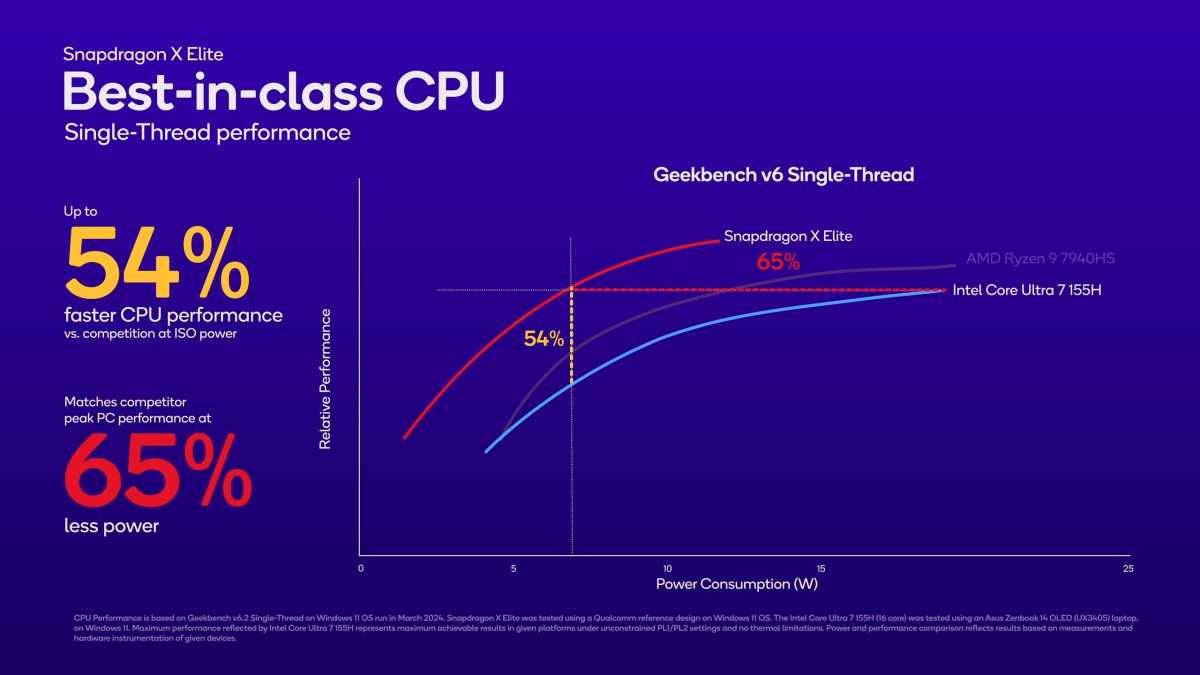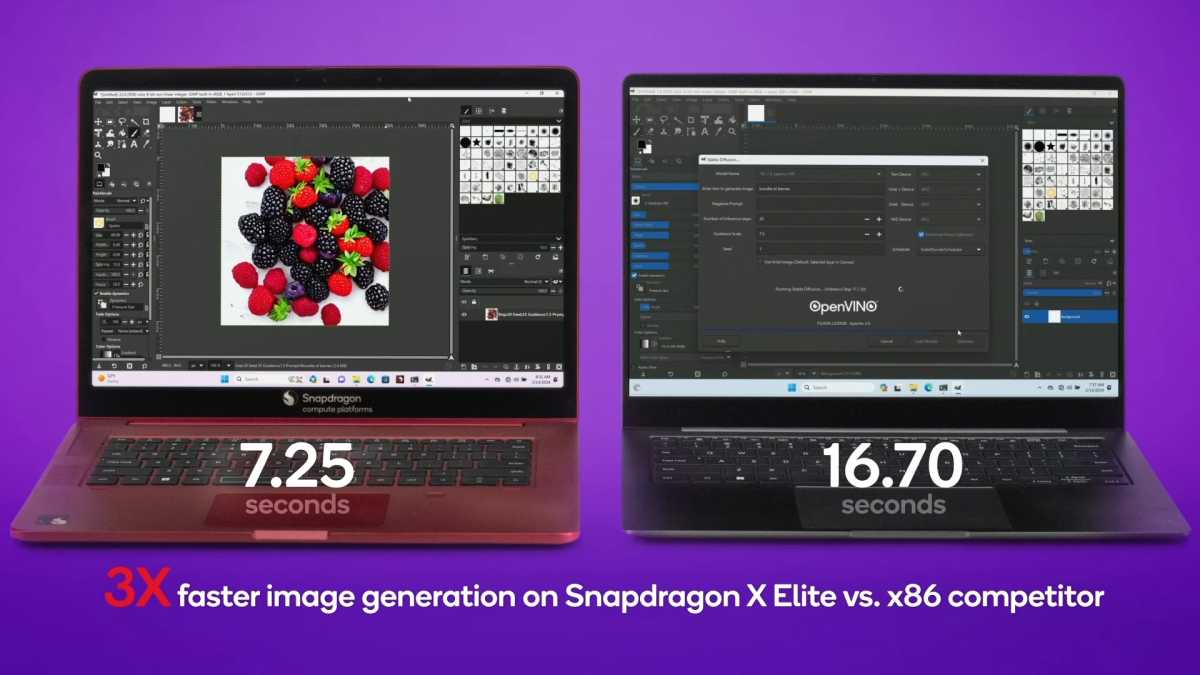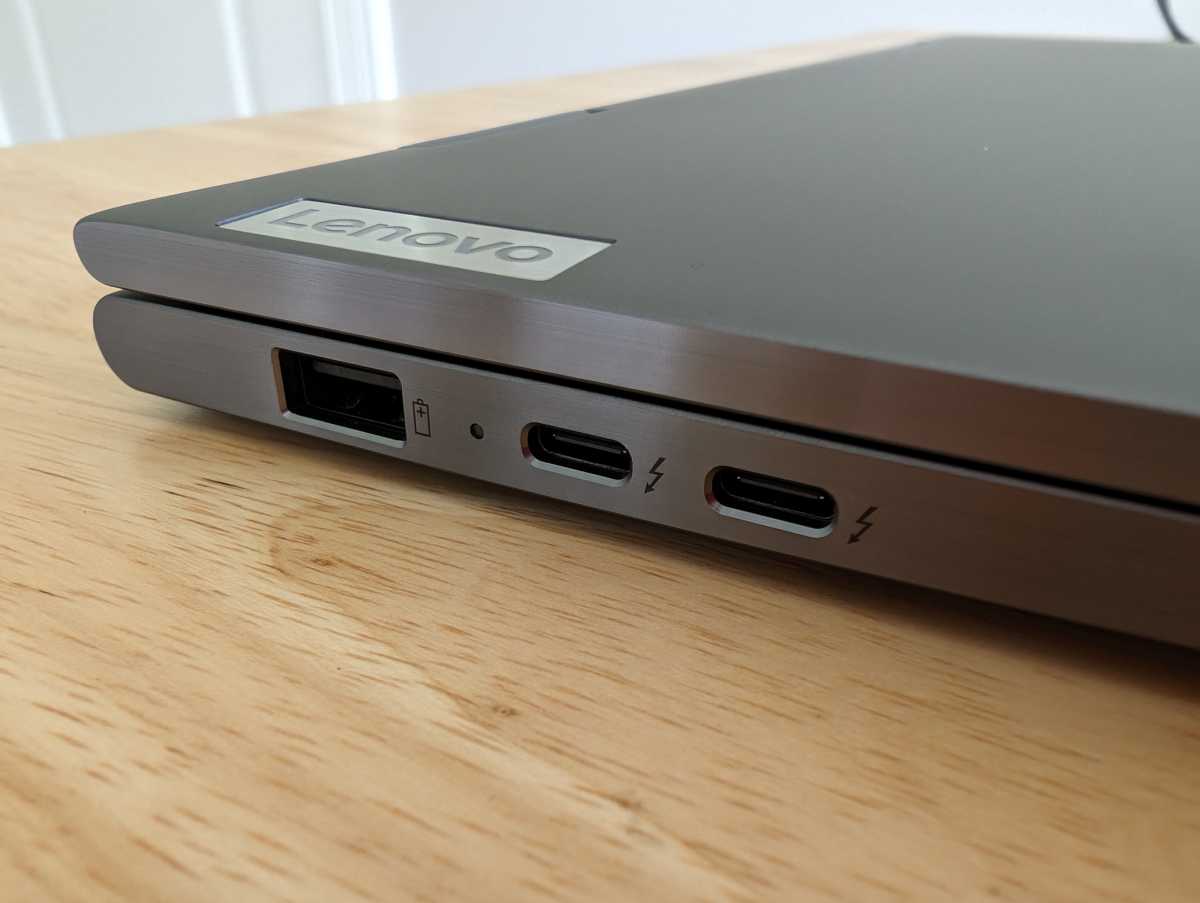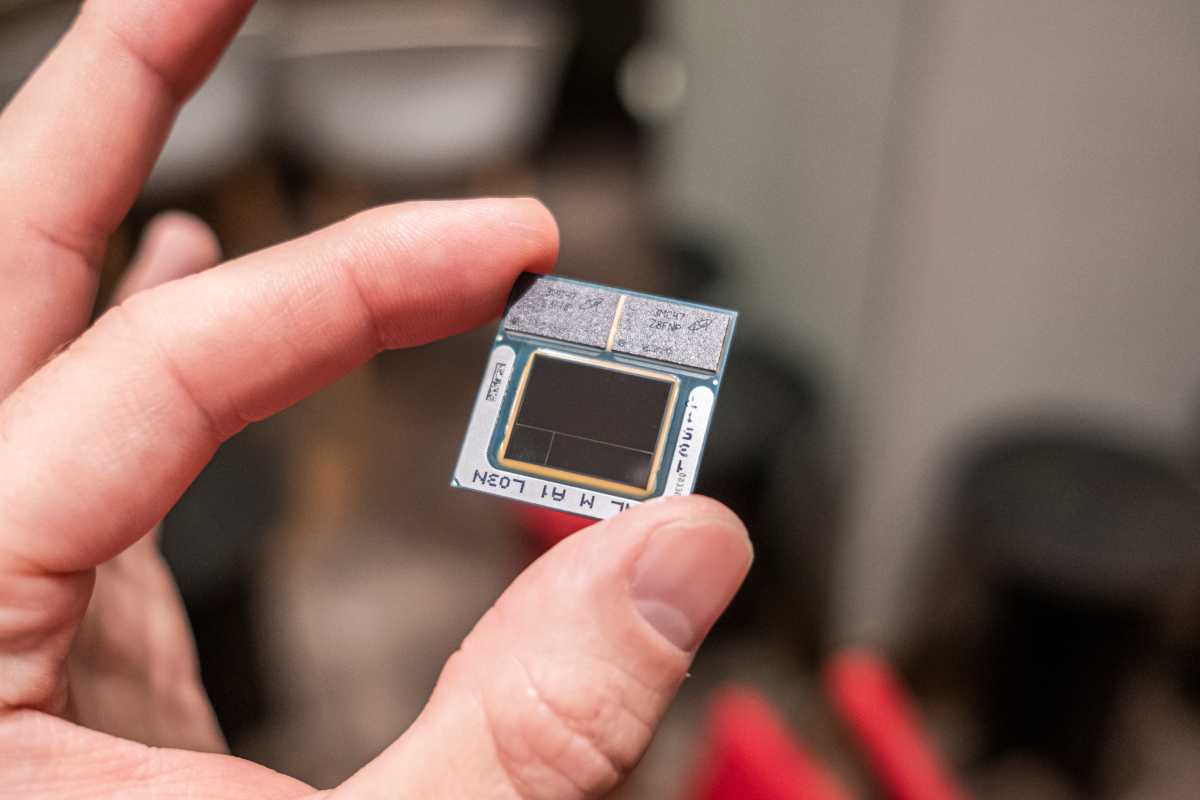Intel is in a tough spot. Qualcomm is comparing its Snapdragon X Elite hardware to Intel’s current Meteor Lake chips, and lots of the numbers don’t look great for Intel. But Intel says it’s still competitive — and that its just-around-the-corner Lunar Lake platform will outshine Qualcomm’s Arm-based Snapdragon X Elite.
“Our mission with Lunar Lake is we wanted to build the most power-efficient x86 architecture there is — period. And we’re feeling pretty confident,” said Intel’s Dan Rogers in an interview with PCWorld’s Mark Hachman at Computex.
That’s great, but Lunar Lake isn’t out today. Intel spent many months talking up the current Meteor Lake platform, promising that it would be more power-efficient and enable local AI experiences with its neural processing unit (NPU.) Intel even transformed its processor naming scheme starting with Meteor Lake — these were the first “Core Ultra” chips.
Now, Qualcomm is about to release the first wave of Snapdragon X Elite-powered laptops, ushering in Microsoft’s new Copilot+ PC era. But Intel wants you comparing it to the Lunar Lake hardware launching in the coming months — not the Meteor Lake hardware you can buy today.
Meteor Lake’s battery life gains weren’t the big leap we expected
I’ve been reviewing a lot of laptops here at PCWorld, and many of them have Meteor Lake CPUs in them. As Meteor Lake was designed more for power efficiency than the previous-generation Raptor Lake hardware, I would expect to see big battery life gains generation-over-generation.
That hasn’t always panned out. Many Meteor Lake laptops have similar levels of battery life to their Raptor Lake ancestors. Some even have worse battery life — the Meteor Lake-powered Lenovo ThinkPad X1 Carbon (Gen 12) actually had lower battery life than the previous-generation Raptor Lake-powered model. Now sure, lots of that battery drain is likely because Lenovo included a beautiful OLED screen that likely sucks a lot of power. But shouldn’t Meteor Lake have big underlying efficiency gains that help counteract that?
I don’t mean to single out Lenovo here. It’s not a Lenovo problem. I’ve encountered a lot of Meteor Lake laptops that don’t offer the big battery life improvements I would have expected from reading about all the architectural changes Intel made in Meteor Lake.
If you listen to Intel’s employees talk about Lunar Lake, it sounds like this problem is resolved. There’s a lot of talk about how applications can now be constrained to run on those low-power E-cores, where on Meteor Lake they might have hit those higher-power P-cores, for example.
“We just don’t believe you need to compromise,” Intel’s Dan Rogers told us in a wide-ranging interview.
Qualcomm is comparing its Snapdragon X Elite hardware to Meteor Lake when it talks up how much better it is than a “Core Ultra” CPU. Intel is saying that Lunar Lake will be able to go toe to toe with Snapdragon X Elite — and surpass it. But if Meteor Lake had delivered the kind of battery life gains we expected, Qualcomm wouldn’t have such a compelling argument to make.
Qualcomm
Meteor Lake CPU performance actually declined a bit
One reality of Meteor Lake is that single-core CPU performance actually declined a bit, generation over generation. It’s a small difference, but the same laptop with a previous-generation Raptor Lake chip might perform a bit better than a current-generation Meteor Lake chip. That Meteor Lake chip might be more power efficient, but it’s an unfortunate truth.
That’s one reason why high-end gaming laptops are often going with those new Intel Core HX chips, which are in fact based on the Raptor Lake architecture. If you want top-end performance, Meteor Lake isn’t the right choice.
It seems like this may be resolved with Lunar Lake, too. Intel is insisting that Lunar Lake delivers both much higher performance and dramatically improved energy efficiency.
“Lunar Lake is kind of a rebasing of mobile architectures for us. We’re trying to communicate to you and the world that this is how we want to do it going forward,” said Intel’s Robert Hallock in an interview with PCWorld while discussing the architectural changes.

Qualcomm
A big part of Qualcomm’s push was that Snapdragon X Elite wouldn’t force you to compromise on performance vs. battery life, illustrated in the chart above. Qualcomm argues that have you can have it all — if you go with Arm-powered Qualcomm hardware, not x86-powered Intel hardware. That’s an easier argument to make when you look at Meteor Lake and you see Intel trading some of the last generation’s performance for improved energy efficiency. Compared to Lunar Lake, Qualcomm’s arguments may look a little less persuasive. Once again, Intel would prefer you compare Snapdragon X Elite to Lunar Lake — not Raptor Lake.
Microsoft is leaving Meteor Lake’s NPU behind
The neural processing unit (NPU) is probably the messiest part of the Meteor Lake story. Intel’s Meteor Lake platform heralded the start of the “AI PC” with its NPU that delivered 11.5 TOPS (trillion operations per second.)
Microsoft dealt Intel a big blow when it revealed that Windows 11’s new “Copilot+ PC” AI features will require at least 40 TOPS. That means they won’t run on Meteor Lake hardware. Qualcomm’s Snapdragon X Elite offers an NPU with 45 TOPS, which has let Qualcomm run a victory lap, touting how far ahead of Intel and AMD it is. Qualcomm can shout “Three times faster AI performance!” from the rooftops. And the company can point out that Intel’s current Meteor Lake hardware can’t even run these new AI features — Microsoft just doesn’t think they’re fast enough.

Qualcomm
That’s a bad look when AI PCs are being so hyped. A lot of us expected Microsoft would support Meteor Lake laptops when it added AI features to Windows, although no one ever promised us that. Now they’re left out in the cold.
This reminds me a bit of that old “Vista Capable” situation. In that case, Microsoft stuck a “Windows Vista Capable” sticker on Intel-powered PCs that didn’t support a variety of Windows Vista features. In this case, Intel Meteor Lake-powered systems were marketed as AI PCs, but they can’t run the big AI features Microsoft is adding to Windows. All I’m saying is that neither situation is ideal for PC buyers.
But Intel’s Lunar Lake has a neural processing unit that can generate 48 TOPS, moving Intel and its PC-making partners away from this inconvenient conversation. This not only catches Intel up — it surpasses Qualcomm’s Snapdragon X Elite AI performance.
Meteor Lake’s GPUs were great, but Lunar Lake looks much better
Intel’s Meteor Lake platform had some great integrated GPUs. Now, you’re still going to want a gaming PC with a dedicated Nvidia or AMD GPU for serious gaming performance — don’t get me wrong.
But Meteor Lake’s integrated Intel Arc graphics hardware was a big leap over the previous Raptor Lake generation, delivering up to twice the performance. We’ve seen it over and over in our benchmarks – it’s a huge leap.
Intel says Lunar Lake will be another huge leap thanks to its architectural changes. Intel is promising 50 percent faster graphics performance compared to Meteor Lake. Based on the benchmarks going around, it seems like Lunar Lake’s GPUs should beat what Qualcomm is offering with Snapdragon X Elite.
Unfortunately, Intel has lagged on integrated graphics performance for so long that, when news of Snapdragon X Elite-powered PCs running current-generation PC games with acceptable performance leaked, people were amazed — even if modern Intel laptops can do the same thing with their integrated Intel Arc graphics.
Intel really needs to get the word out on how good its integrated graphics are becoming.
Thunderbolt ports are becoming less confusing
People don’t really understand Intel’s Thunderbolt 4 standard. Thunderbolt 4 uses the USB-C connector shape — you can think of Thunderbolt 4 ports as upgraded USB-C ports that are guaranteed to support fast speeds and features.
But things have been messy. Many Meteor Lake laptops have both Thunderbolt 4 and traditional USB-C ports, mixing and matching them. Some Meteor Lake laptops don’t have Thunderbolt 4 ports at all. And laptops don’t always properly label which ports are Thunderbolt 4 ports and which aren’t, forcing you to dig into the spec sheet to see what’s going on.
Intel is fixing a lot of the confusion here. All Lunar Lake systems will have a minimum of two Thunderbolt 4 ports.

Chris Hoffman/IDG
Intel also says that it is “strongly encouraging” manufacturers to place Thunderbolt ports all on one side of the laptop, stop mixing and matching Thunderbolt ports, and label them clearly. That’s all good to hear — but the words “strongly encouraging” suggests this is still optional for PC manufacturers, not required.
Thunderbolt is something Intel holds up as a unique advantage of its platform. If it was less confusing, people would be able to understand what they have available — and take better advantage of it.
Wi-Fi 7 and Bluetooth 5.4 will be everywhere
Most Meteor Lake-powered computers have Wi-Fi 6E and Bluetooth 5.3. That’s not the end of the world because Wi-Fi 7 routers aren’t widespread yet. And you can get Wi-Fi 7 and Bluetooth 5.4 on some Meteor Lake laptops — you’ll often just have to pay for an upgrade when configuring the laptop.
Against that backdrop, Qualcomm arrived and advertised that all its computers supported future-proof Wi-Fi 7 and Bluetooth 5.4. It was another great comparison to the stodgy-seeming old Intel x86 PCs and their charging extra for Wi-Fi 7 as an optional upgrade.
Lunar Lake rights the ship once again, including Wi-Fi 7 and Bluetooth 5.4 in a more fully integrated way. It sounds like we should be seeing it on all those upcoming Lunar Lake-powered laptops.
Intel wants everyone’s eyes on Lunar Lake, not Meteor Lake

Intel’s Lunar Lake CPU.
Adam Patrick Murray / Foundry
Just a few months ago, it seemed like Meteor Lake with its new “Core Ultra” branding was the hot new architecture that was going to usher in a more power-efficient future alongside AI features in Windows.
But, time moves quickly, and that story is already in the rearview mirror. Now, Intel wants you to focus on Lunar Lake and how it will beat Qualcomm’s Snapdragon X Elite hardware at its own game. Intel wants you to compare Snapdragon X Elite to Lunar Lake — not Meteor Lake. (But Qualcomm would love to compare Snapdragon to Meteor Lake, since that’s what’s available in laptops shipping right now. Expect to see a lot more of those comparisons from Qualcomm.)
The only problem is that Qualcomm’s Snapdragon X Elite-powered Copilot+ PCs will arrive in a few short weeks, on June 18. They’ll be sitting on the store shelves next to Intel Meteor Lake laptops.
Lunar Lake won’t arrive until sometime in the third quarter of 2024 — “in time for the holiday season.” Unfortunately for Intel, it’s giving Qualcomm a head start.



